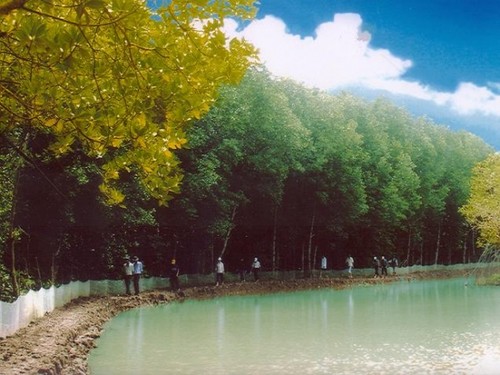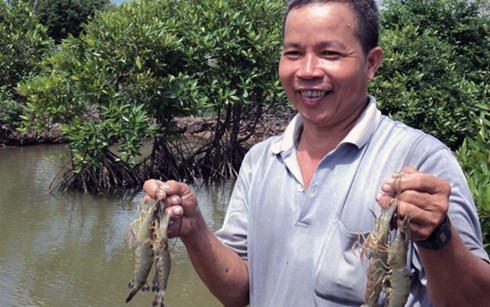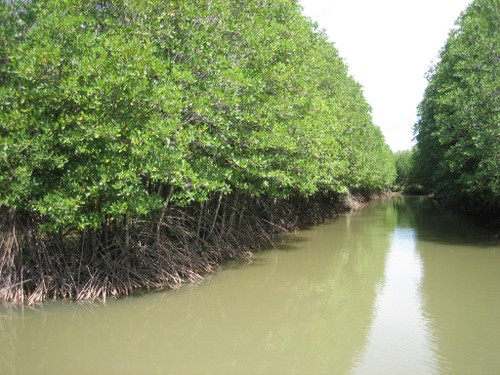(VOVworld) – Thousands of farmers in the Mekong Delta province of Tra Vinh have earned relatively high incomes from aquaculture under the canopy of mangrove forests. This production method has helped farmers gain stable revenue and localities quickly restore their coastal mangrove forests.
 |
The mangrove forest in Duyen Hai district, Tra Vinh province (Photo: tinnongdulich.com)
|
Over the past decade, many intensive shrimp farmers in Hiep Thanh commune in Duyen Hai district faced difficulties because shrimp died from unfavorable weather and environmental conditions.
On the contrary, with half of the 4.5 hectares of the water surface covered by arenga forest, Pham Van Huan’s family earns a profit of nearly 7,000 USD each year from shrimp farming.
 |
Phan Van Huan and a harvest of shrimp raised under the canopy of mangrove forests
(Photo: Sa Oanh) |
Though the earnings are not high, the model requires less investment, management costs, and care. Recently Huan has continued to invest in planting additional 3 hectares of forest to expand coverage and the area for shrimp aquaculture.
He said his family “faces fewer risks if we only raise shrimps. We may gain less profit from raising both crabs and fish, but the model is more sustainable. All the areas are used for forest shrimp culture. But our forest is young, we haven’t fully tapped its potential.”
Phan Van Canh from Long Vinh commune in Duyen Hai district said his family suffered losses in three consecutive years and got in debt. In the past when he and other households newly settled down in the village, they used to cut trees and build ponds to raise shrimps. Their first harvests were good but subsequent catches were not profitable.
Canh explained “since we re-planted forest and raised shrimps and crabs by improved techniques over extensive shrimp culture with food completely relying on nature and supplementary food per week, we have earned more than 5,000 USD a year.”
Raising shrimp under the canopy of mangrove forests with improved extensive techniques has more advantages than intensive cultivation and it even helps to protect the environment.
Tran Truong Giang, head of the agriculture and rural development section of Duyen Hai district, said “the model requires less investment, risks, and is suitable to farmers who live along coastal places. Statistics show that 80% of shrimp farmers who apply improved extensive techniques have made profits.”
From 2010 to 2014, farmers along the coastal areas in Tra Vinh province invested in growing nearly 3,200 ha of forest for aquaculture, increasing the province’s area of mangrove forests to more 7,500 ha.
 |
| The arenga forest grown by farmers (Photo: tinnongdulich.com) |
The project was implemented in 12 communes in the three coastal districts of Chau Thanh, Cau Ngang, and Duyen Hai.
According to Tran Van Tri, head of the forest management and protection section of the provincial Forest Ranger Department, “the shrimp raising model in combination with afforestation has resulted in higher efficiency and sustainability than the traditional method. Its economic efficiency has drawn public attention to re-planting forest.”
Aquaculture under the canopy of mangrove forests has helped coastal farmers improve their living condition, conserve and develop the ecosystem of mangrove forest in Duyen Hai district, and better respond to global climate change.